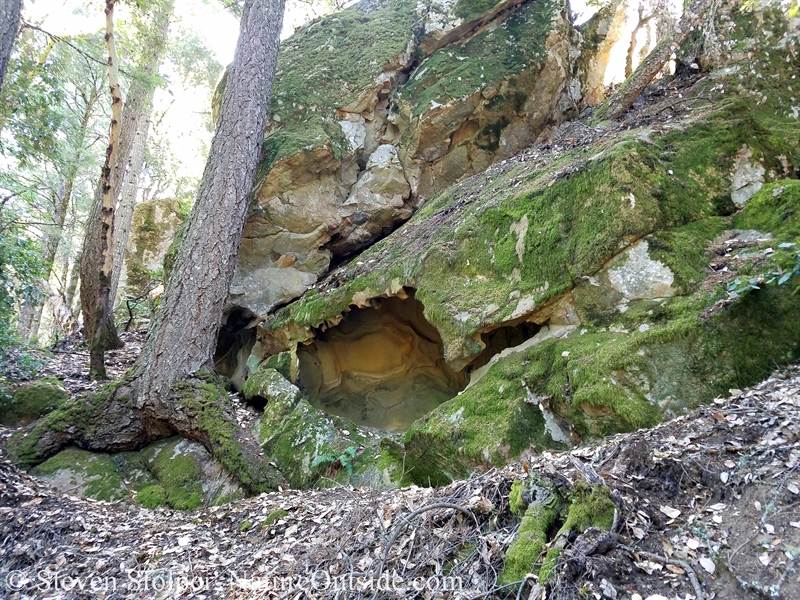
I didn’t set out to find the caves. I was searching for solitude.
Like my neighbors, I was staying-at-home as COVID infections peaked. And the time indoors had been wearing on my spirit.
Sometimes we need to rattle the cage we’ve built for ourselves. And I was in a cage-rattling mood.
The Plan
I’m eager to commune with nature this bright summer Saturday. My goal is to avoid the crowd by hiking a trail connecting two open-space preserves. Most people hike deep into the preserves and don’t travel on foot between them.
In my younger days I would have been a “Trail Tiger,” barreling down the dusty paths, reveling in the miles I covered. But today I plan to wander at a leisurely pace.
The great naturalist John Muir would have approved. He hated the term “hiking.” He preferred the term, “saunter.”
I don’t like either the word [hike] or the thing. People ought to saunter in the mountains – not ‘hike!’ Do you know the origin of that word saunter? It’s a beautiful word. Away back in the middle ages people used to go on pilgrimages to the Holy Land, and when people in the villages through which they passed asked where they were going they would reply, ‘A la sainte terre’, ‘To the Holy Land.’ And so they became known as sainte-terre-ers or saunterers. Now these mountains are our Holy Land, and we ought to saunter through them reverently, not ‘hike’ through them.
– John Muir
A Sudden Detour
The warm morning fortells a sweltering day. A covey of California Quail scatters at my approach. I chuckle as many of the birds run into the bushes instead of flying. Their legs blur as the handsome tan, black, and bluish birds dive for cover.
I come to a trail junction. Branching from the main trail is an unmarked path through the scrub. On impulse, I veer down it and come to an old sign, “Not a through trail.”
I halt as I’m struck by a memory. About 15 years earlier, a local “Mountain Man” told me about a cave system in this area. I do not use the local name for these caves to preserve their anonymity.
The caves have a long colorful history among the locals. But they don’t appear on any trail maps. And many of the mountain residents who frequented them are no longer alive. A small number of rock climbers know the location because the rock formation nearby can be used for bouldering.
Soon after learning about them, I had tried to find them — and failed. I blundered down a social trail on a wet winter day. Every ten feet I’d discover another tick crawling on my body. And then I reached a point in my journey where I needed to cross a stream. It had been an especially wet winter. And the river was swollen with a rush of fast-moving currents. Further down it plunged into a roaring fall.
I turned back and returned home to remove the last of the ticks trying to get through my clothing.
Since that hike 15 years ago, I never tried to find the caves. I think it was the ticks that put me off.
But today, the hike looks inviting. It’s been a dry summer and I should be able to hop across the creek.
I sling my backpack onto my shoulders and head down the dead-end trail.
Through the Forest
I reach the end of the trail where I’m confronted by another sign. I don’t remember seeing it when I was last here. It warns that the trail beyond is unmaintained and I proceed at my own risk. I pause for a moment before plunging into the underbrush.
The “social trail” is overgrown in spots, but seems to be in better shape than I remembered. After hiking half a mile, I come to the stream crossing. But today the stream is a trickle, and I leap across it triumphantly.
Now there is no trail. But I know from my long-ago conversation with the mountain man that I must climb a steep hillside.
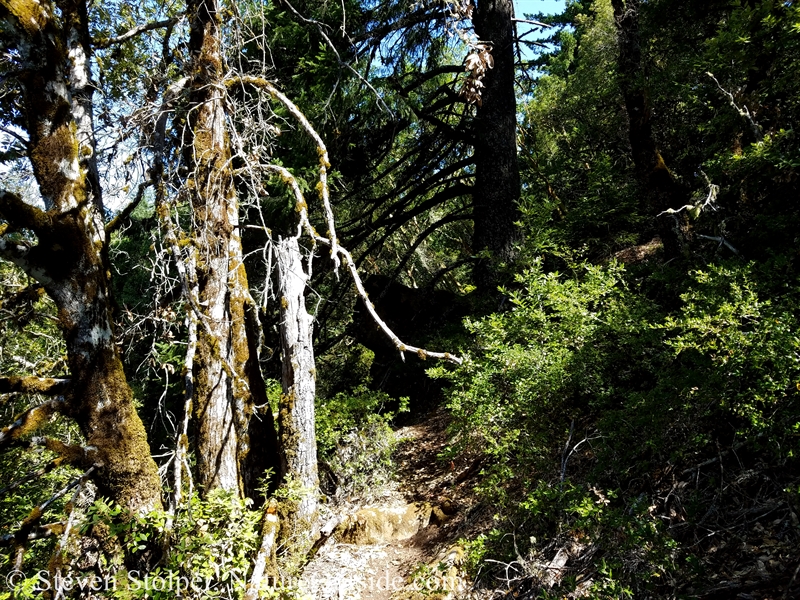
The social trail
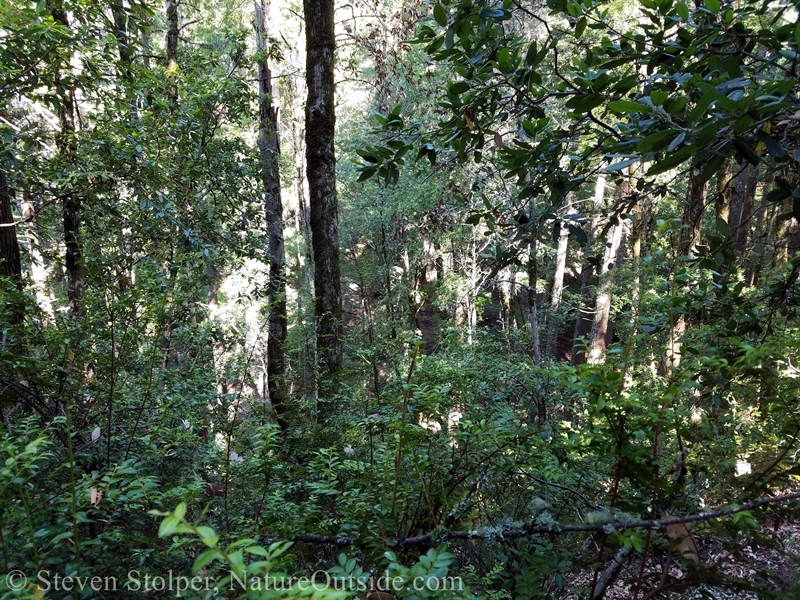
As I climb the hillside I look back, down into the forest
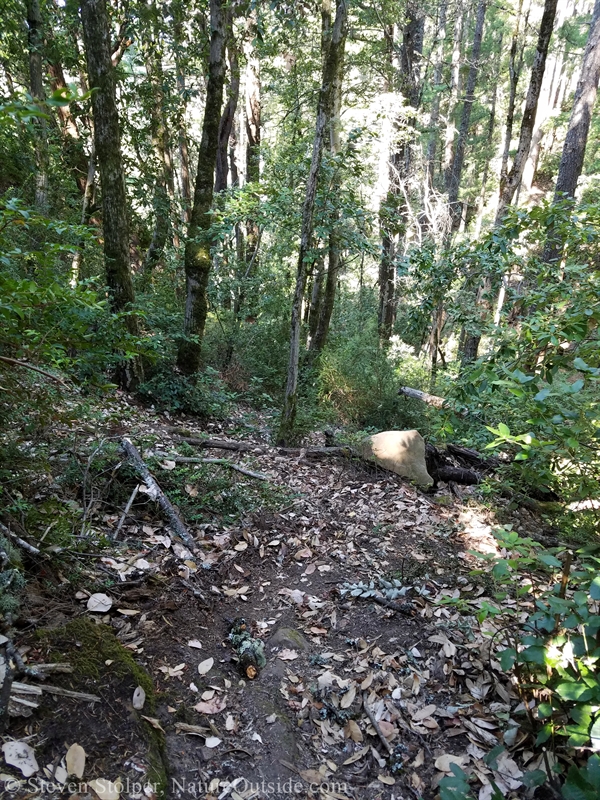
The footing is uncertain. Looking down the hillside as I climb.
Suddenly, the opening of a cave gapes from the undergrowth.
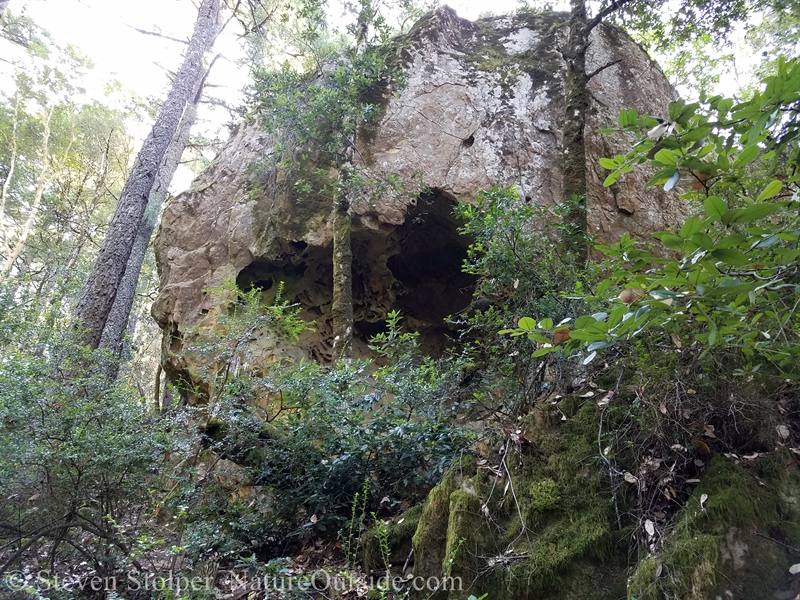
Through the brush above me, I see the entrance to a cave.
I feel like Indiana Jones as I scramble toward it. But as I arrive, I’m shocked to discover a sign:
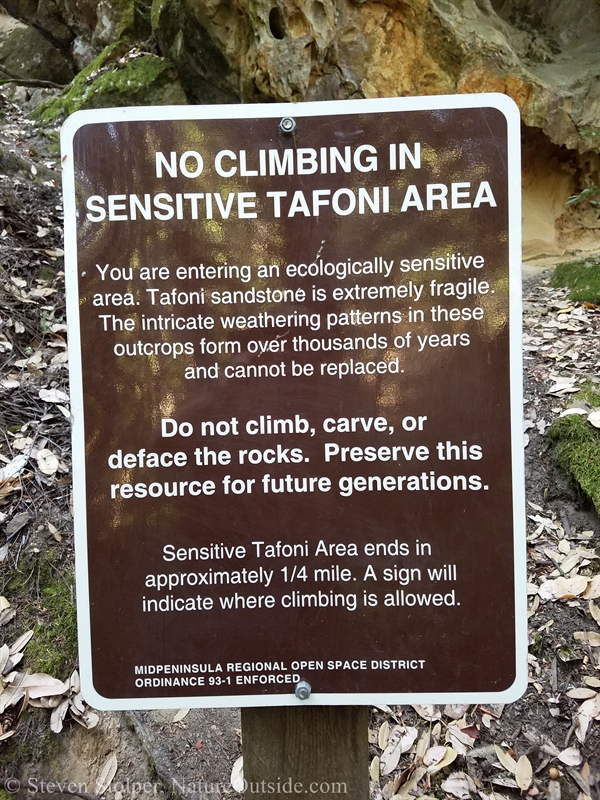
The unexpected sign.
Several things about the sign shock me. Its presence means the authorities have adopted an “if you can’t beat them, place signs” approach. They cannot hide the site or keep people away, so they will prompt them to behave responsibly.
I’m also disappointed. If there is a sign, it must mean enough people come here to warrant one. Mentally, I’m prepared to find caves spoiled by graffiti, carving, and trash.
The third thing that shocks me is the phrase, “Sensitive Tafoni area ends in approximately ¼ mile.” A quarter-mile of tafoni! I’ve never heard of such an extensive formation!
Tafoni are a weathering pattern in the rock. It looks like a honeycomb full of “swiss-cheese” like cavities where the rock has weathered away. To me, tafoni look like spider webs made of rock.
The rock that makes up the Santa Cruz Mountains was once at the bottom of the Pacific Ocean. Tafoni are made from sandstone cemented together by calcite (calcium carbonate, CaCO3) from the shells of ancient marine creatures. The calcite is soluble in water. During our wet winters, moisture wicks through the porous rock and dissolves the calcite. This creates the distinctive lacy weathering pattern.
There are examples of Tafoni throughout the Santa Cruz Mountains. They occur in clusters on vertical or inclined faces protected from surface runoff – like in caves. I’m always surprised when I find a formation hiding in some hollowed-out boulder deep in the forest.
But it’s not common to see them. And a quarter-mile formation blows my mind.
The Caves
As I approach the cave-mouth I’m struck by two things: I can walk right up to the cave and there is *no* evidence that humans have been here. There is no litter, no graffiti, no carving, no broken tafoni. I’m astounded at their pristine condition. Tafoni are delicate, and these are in perfect condition.
I do not enter the cave. And I take great care not to step on any of the rocks near the entrance. The tafoni are in amazing condition and I don’t want to do anything to ruin them.
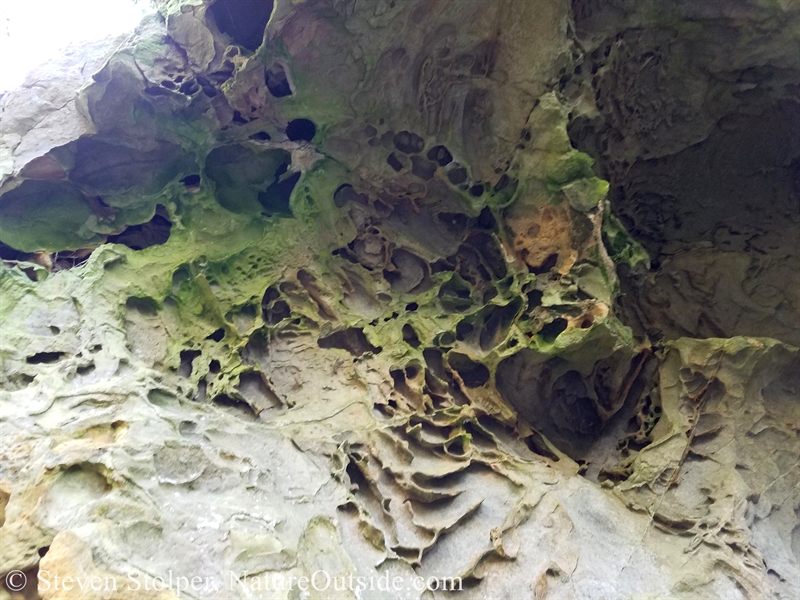
Tafoni
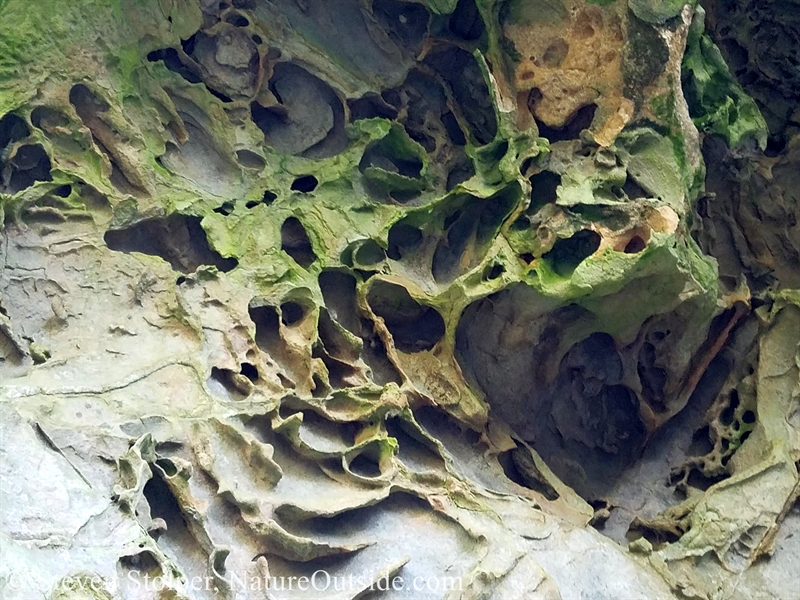
The cave walls are all tafoni
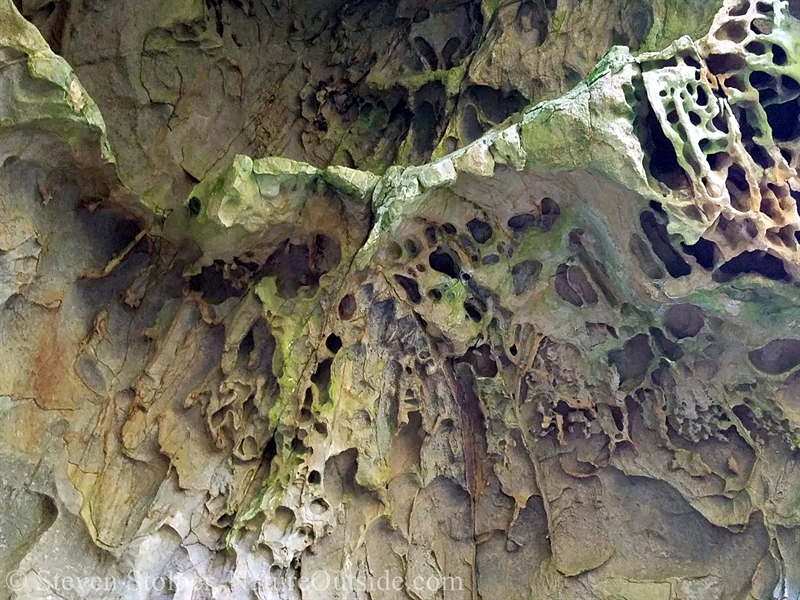
The cave walls have intricate patterns
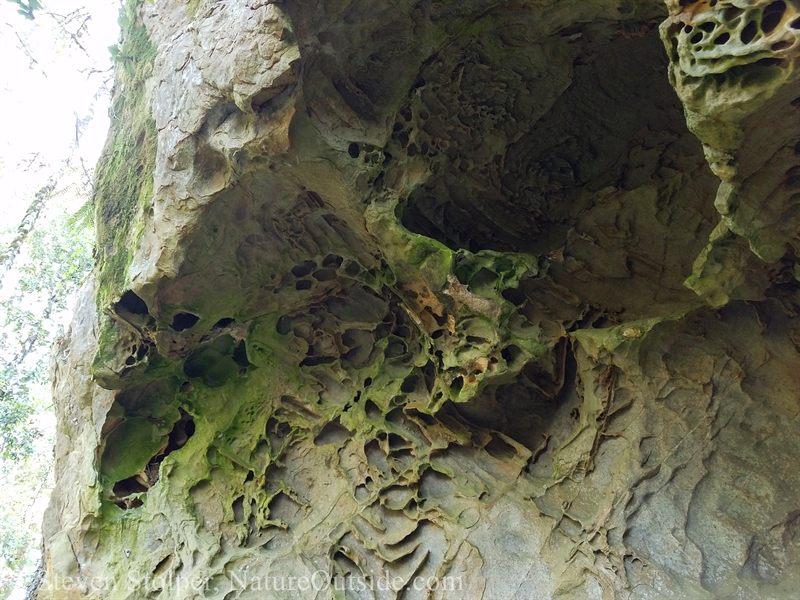
The caves are shallow, and I can take photographs without entering them
Some of the tafoni are quite deep.
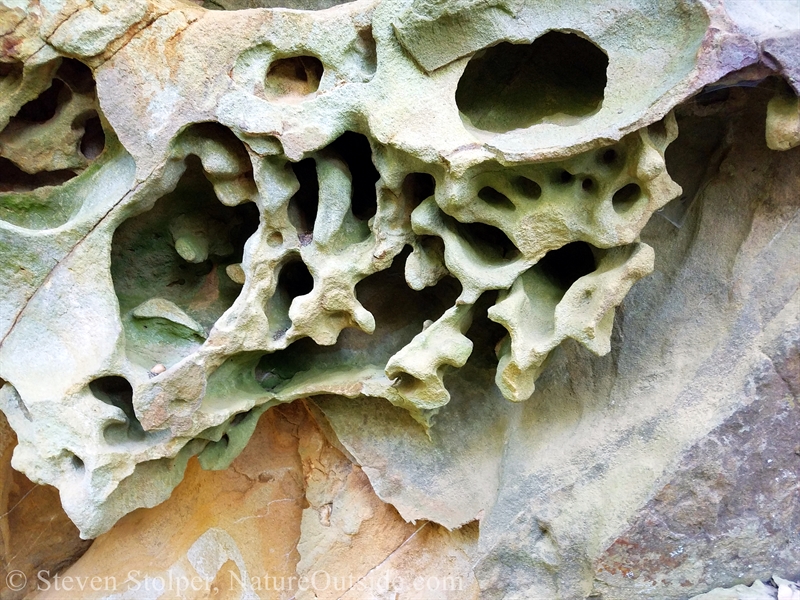
Tafoni
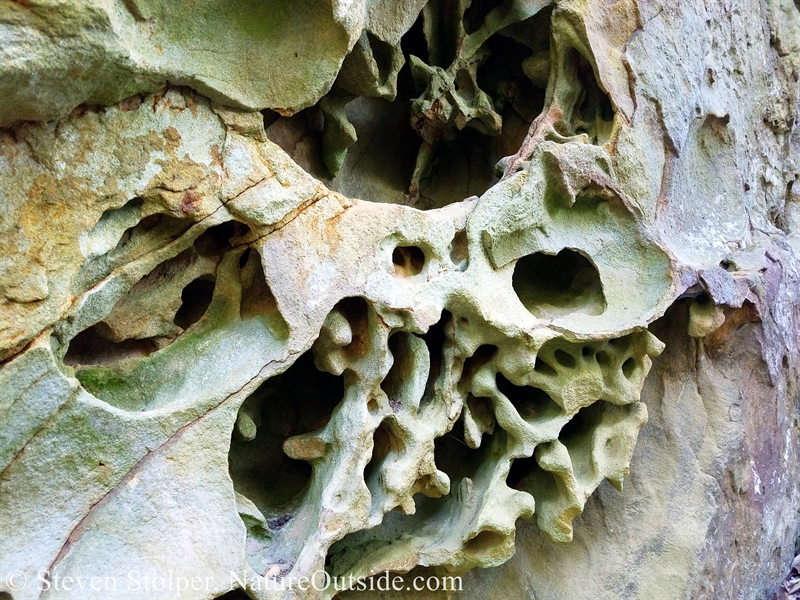
Patterns made by thousands of years of weathering
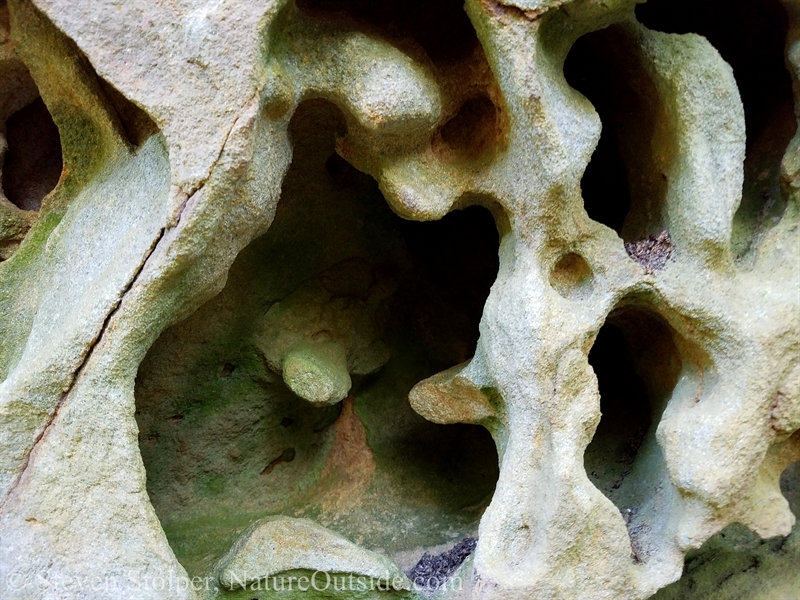
Looking inside a tafoni
I walk along the perimeter of the rock formation and find two more caves.
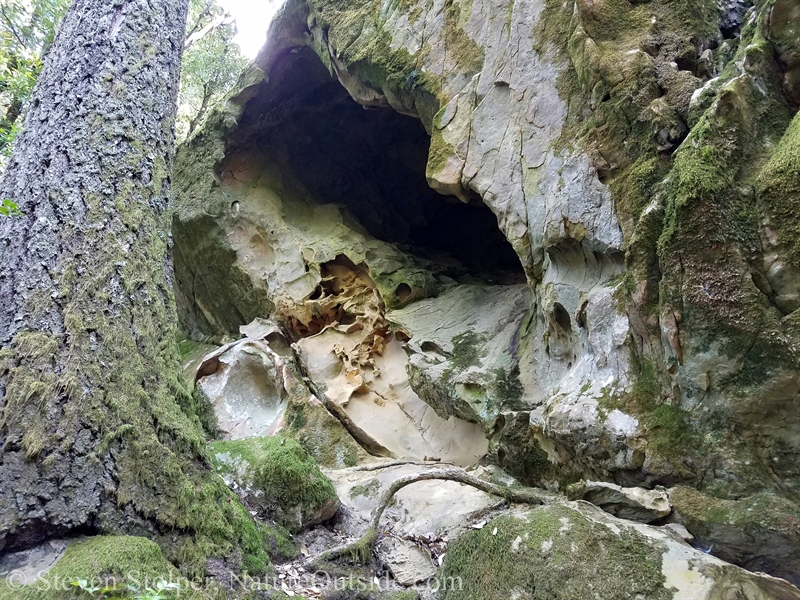
Another cave
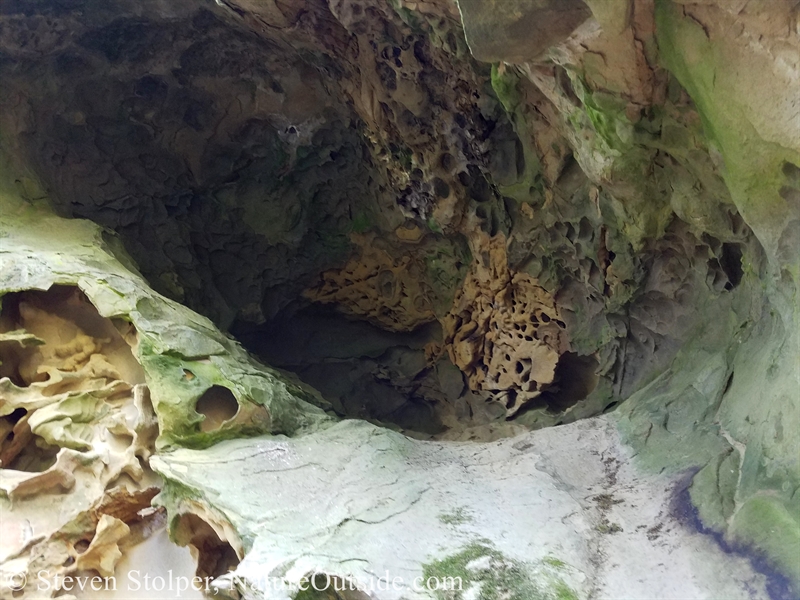
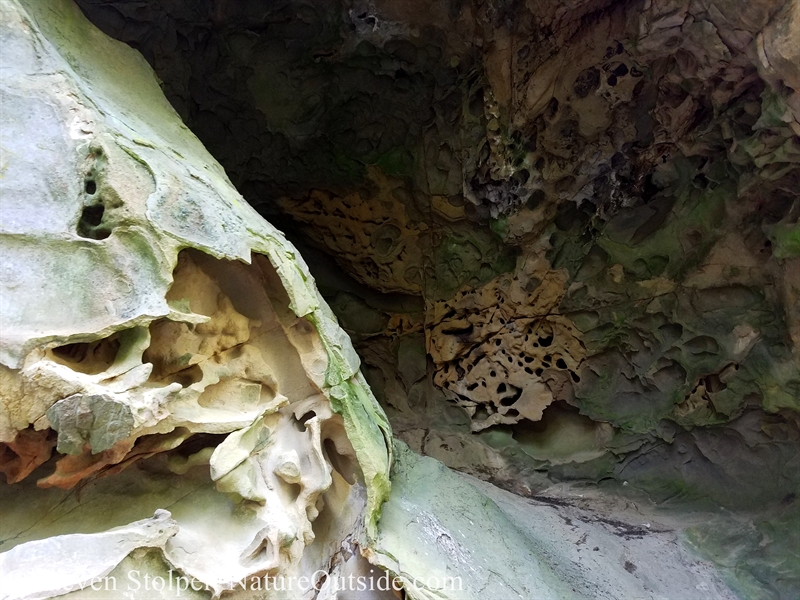
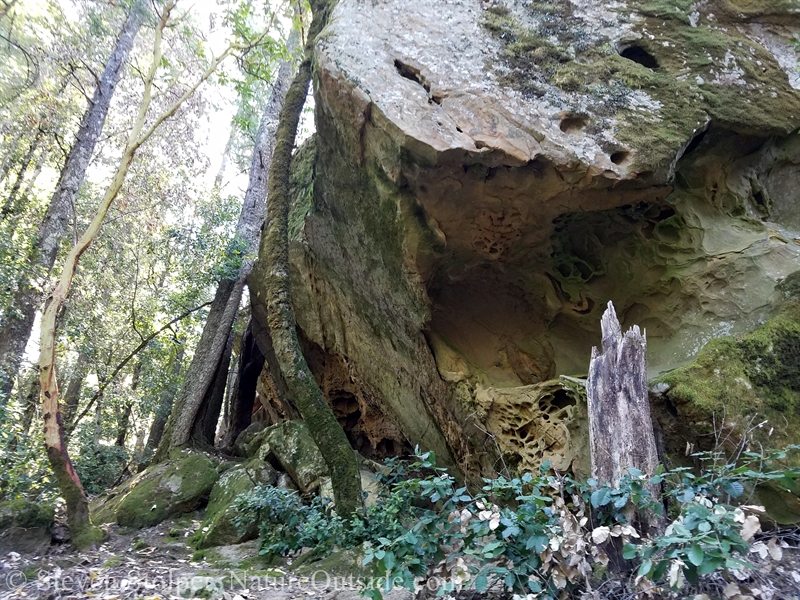
A short walk and another cave…
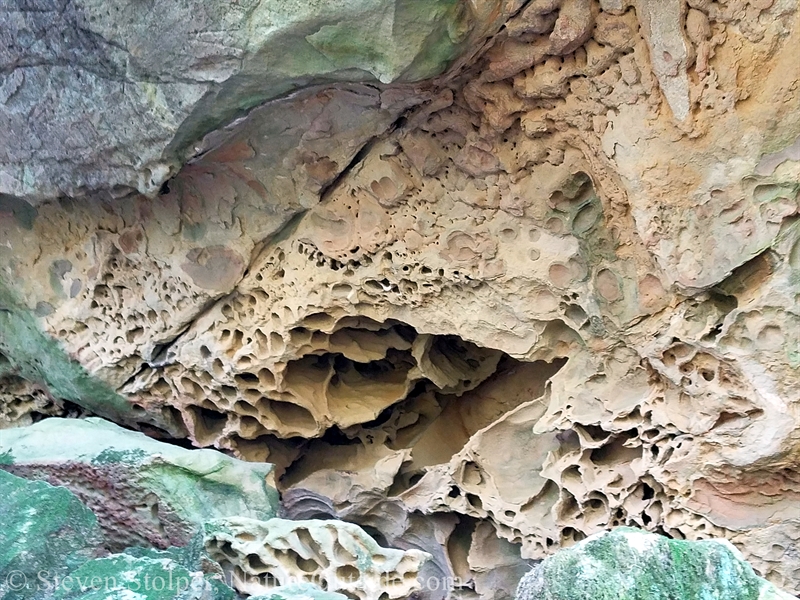
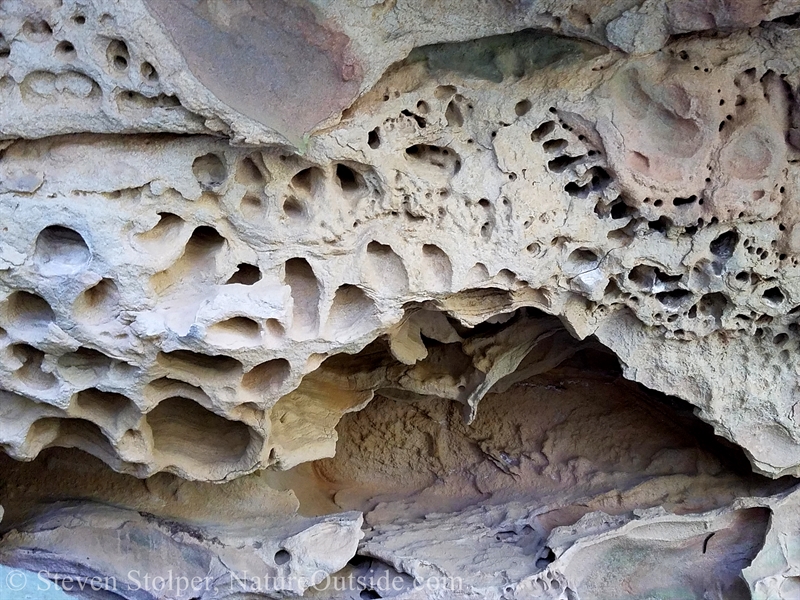
Here are two pictures to show scale. The tafoni are behind me, which makes them look slightly smaller. I stood outside the caves. I never entered them, or even touched the rocks at the cave entrances. I made sure that future visitors would have the same awesome experience as me.
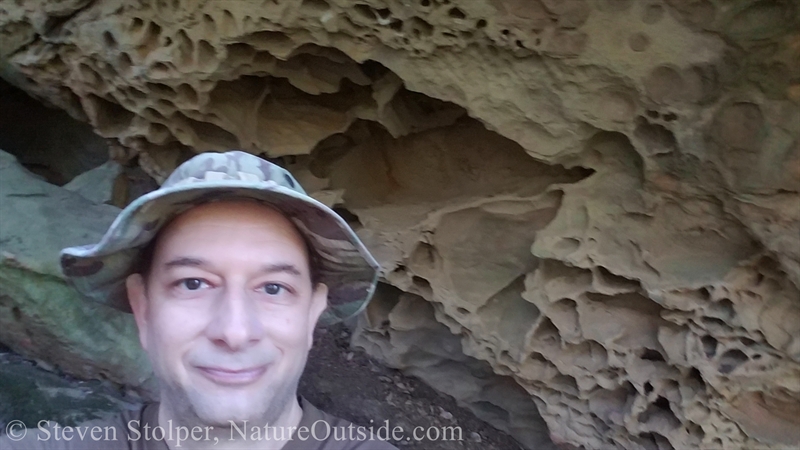
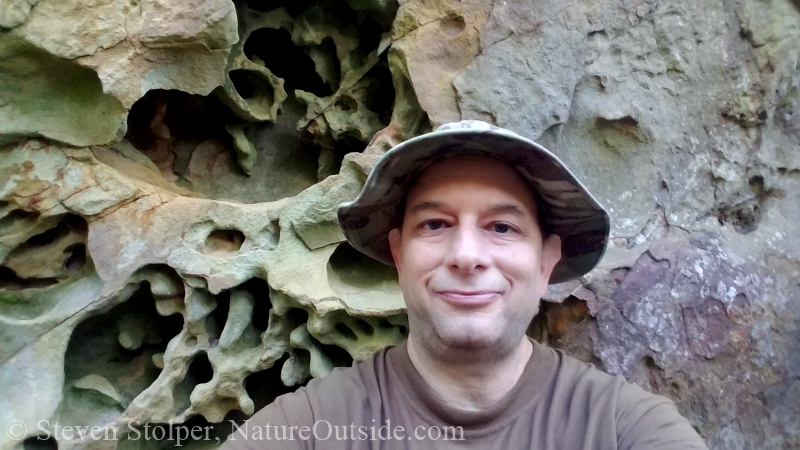
Another Discovery
Through a break in the forest, I can look across the Santa Cruz Mountains.
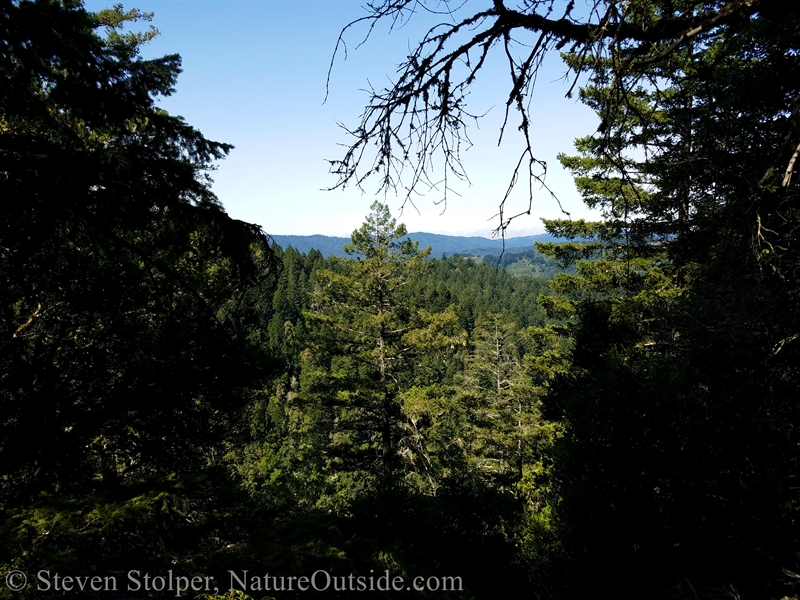
A break in the trees lets me look out from the hillside to see the Santa Cruz Mountains
As I turn for home, a movement near my feet catches my eye. It’s a giant millipede! I believe it is a Tylobolus species. It’s hard to tell from my photographs, but this one is close to five inches long.
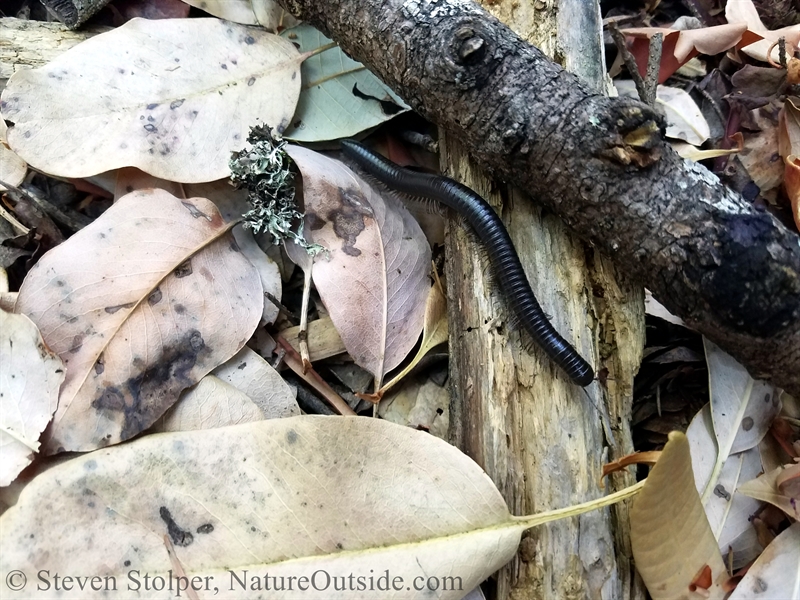
Tylobolus millipede
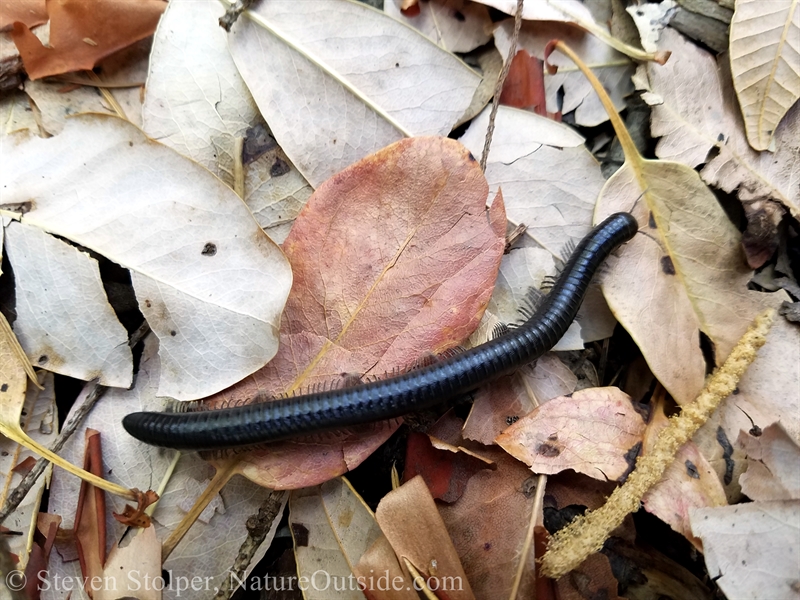
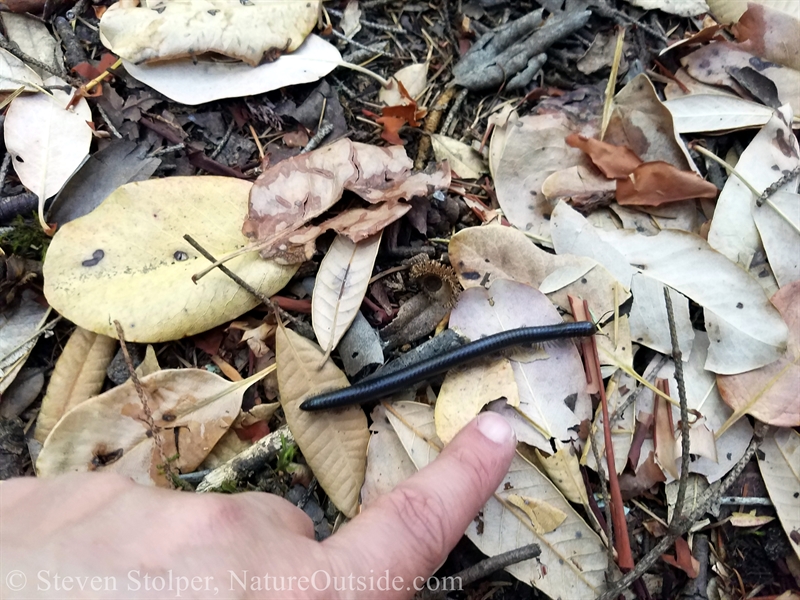
My finger looks larger because it is closer to the camera
Mission Accomplished
I descend the steep hillside, cross the creek, and saunter back to the maintained trail. The noonday sun is beginning to cook the landscape. I head home excited and refreshed.
I’m eager to saunter another day.
Related Articles on NatureOutside
Off the Map Adventure – The Sandstone Caves
Yosemite: Living the High Life at Sentinel Dome
For fun facts and useful tips, join the free Bushcraft Newsletter.



Leave a Comment